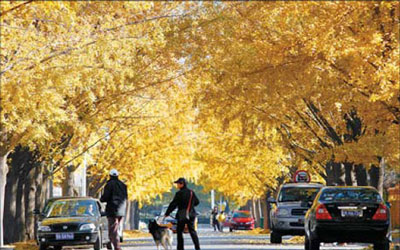|

|
|
Locals take a walk along a ginkgo-lined road in Beijing. [China Daily] |
I love the change of seasons and my favorite autumn sight in Beijing is the transformation of the Ginkgo biloba (yin xing) trees as they prepare for a chilly winter.
In the next few weeks a golden ochre color will work its way from the outer edge of the tree's fan-shaped leaves toward the stem. The tree will stay a glowing mass of gold for a few days and then dramatically and simultaneously, the leaves will fall.
This picturesque scene is often accompanied by a far less romantic odor as the ripened berries from the female trees also fall to the ground. They emit an indescribably putrid smell due to a particular acid in their fleshy outer layer that is also found in rancid butter, vomit and body odor. That would explain it.
Amazingly this smell does not deter many Chinese people who journey to ginkgo-lined avenues at this time of year to collect these prized fruits. Once the soft, stinky flesh is removed, a hard brown shell is revealed which houses the edible white ginkgo nut (bai guo).
If handling the fresh fruit yourself, ensure you wear gloves to remove the flesh as it may cause contact dermatitis.
At the moment, ginkgo nuts can be bought fresh from some food markets in Beijing but they are more commonly available either dried or canned in Chinese supermarkets.
If buying them fresh, ensure they are roasted or cooked before being eaten because they may be toxic uncooked.
In Chinese cuisine they may be roasted and served as snacks or added to a variety of soups, stews and congees.
Buddha's Delight (luohan zhai) is a sumptuous vegetarian dish which includes ginkgo nuts among various ingredients, such as bamboo shoots, wood ear fungus, lily buds, starch noodles, tofu, water chestnuts, carrots, cabbages and black mushrooms.
In Japan, ginkgo nuts are embedded in a dish called "chawanmushi", a steamed savory egg custard that may also include prawns, chicken and vegetables.
Ginkgo nuts have a high starch content and are low in fat, with a 30 g portion providing around 30 kcal. They have a mealy, bean-like texture and a bland, slightly sweet flavor.
They are thought to boost blood supply around the body and reduce the blood's stickiness. They may also counteract the effect of harmful free radicals when they enter the body and may affect chemicals that alter nerve control.
Moreover, the extract from ginkgo leaves has in recent years become an increasingly popular alternative medicine supplement across the world.
Typically it is used to protect against or treat dementia and Alzheimer's disease but it may also be prescribed for depression, anxiety, concentration problems, tinnitus and headaches.
Anecdotal and historical accounts of the efficacy of ginkgo, especially in relation to dementia and Alzheimer's, abound but scientific evidence is far less conclusive. The Cochrane Database, a collaboration which carries out large systematic reviews of research trials, concluded in 2006 that ginkgo was safe to use for dementia and cognitive decline compared to a placebo, but that evidence that is has "predictable or clinically significant benefits is inconsistent and unconvincing".
In light of a dearth of well- designed studies, the National Center for Complementary and Alternative Medicine (US) is currently carrying out a large scale 8-year study involving 3,000 subjects due for completion in July 2009.
Meanwhile, there is one other thing to bear in mind. According to traditional Chinese medicine, ginkgo is considered an aphrodisiac and so it may be a useful addition to your store cupboard!
?(
China Daily September 24, 2008)